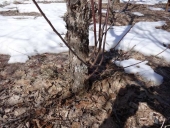
 1
1





 1
1




Owner, Etta Place Cider



















Owner, Etta Place Cider








 1
1








John Wolfram wrote:Just last month I finished up moving 75 trees from my house nursery out to my orchard and while I did produce probably $1000+ worth of trees for less than $100, I will not be having a tree nursery at my house again. Instead, I will plant rootstock onsite at the orchard and graft out there since it is so much faster. I know the original poster said he has more money than time, but lets compare the amount of time needed to use a house nursery as compared to just planting on site. In both cases, you need to plant rootstock and then graft it over, so that's a wash. If you use a nursery then you need to dig up the tree (~40 minutes for two year tree if you are trying to save as many roots as possible), fill in the hole you left (~5 minutes), you need to dig a much larger hole out at final location than you would for rootstock(~30 minutes depending on how many rock/roots you hit), and you need to plant the larger trees (~15 minutes). All together, I figure using a nursery out at my house added 90 minutes of work per tree. That amount of time is not a big deal if you are only moving a couple of trees, but if you are putting in a 6 acre orchard with trees at 20x20 spacings that would add 900 hours of work compared to just planting rootstock directly out at the orchard.





|
I want my playground back. Here, I'll give you this tiny ad for it:
Rocket Mass Heater Resources Wiki
https://permies.com/w/rmh-resources
|





